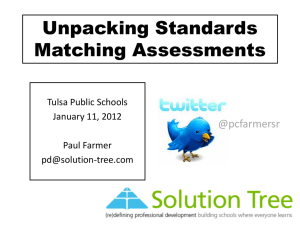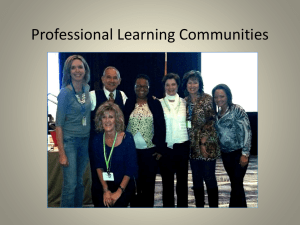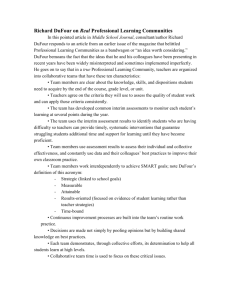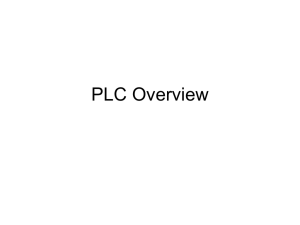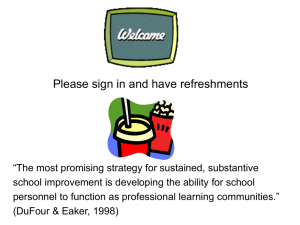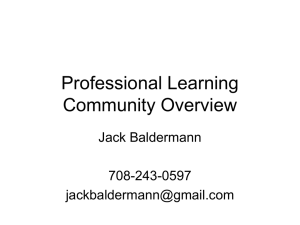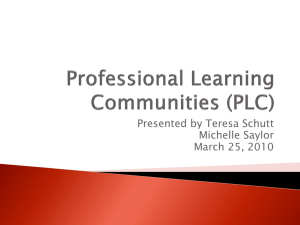Professional Learning Communities Overview
advertisement
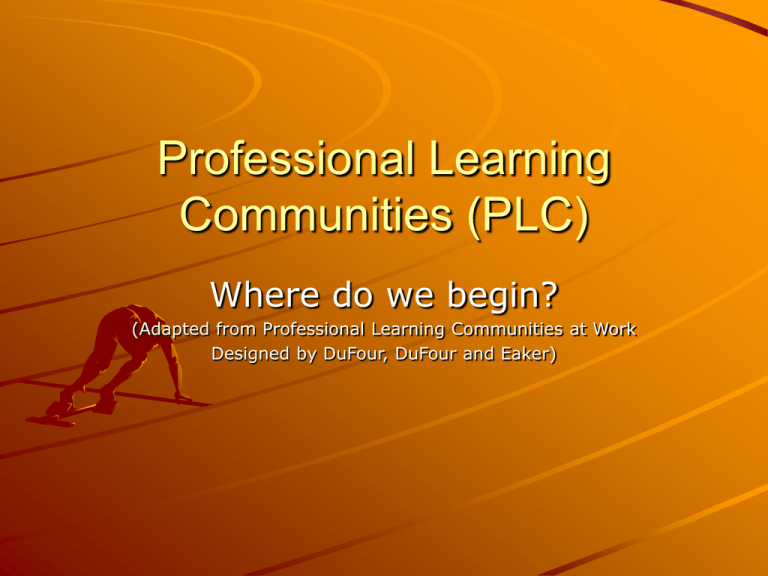
Professional Learning Communities (PLC) Where do we begin? (Adapted from Professional Learning Communities at Work Designed by DuFour, DuFour and Eaker) What does PLC mean? An on going- process in which educators work collaboratively in recurring cycles of collective inquiry and action research to achieve better results for the student they serve. PLC’s operate under the assumption that the key to improved learning for students is continuous, job embedded learning for educators. DuFour, DuFour, Eaker and Many (2010) PLC Big Ideas & Core Values Ensuring that students learn –Learning for all A Culture of Collaboration –Teamwork Focus on Results –Data-Driven Decisions The PLC Big Ideas #1 LearningWe accept learning as the fundamental purpose of our school and therefore are willing to examine all practices in light of their impact on learning. “the fundamental purpose of the school is to ensure that all students learn rather than see to it that all students are taught-an enormous distinction.” from Raising the Bar and Closing the Gap-Whatever it Takes Critical Questions of Learning 1. What is it that we expect them to learn? 2. How will we know when they have learned it? 3. How will we respond when they don’t learn? 4. How will we respond when they already know it? The PLC Big Ideas #2 Collaboration- To co labor We are committed to working together to achieve our collective purpose. We cultivate a collaborative culture through development of high-performing teams. A systematic process in which we work together, interdependently, to analyze and impact professional practice in order to improve our individual and collective results. DuFour, Dufour & Eaker Why Collaborate? Gains in student achievement Higher quality solutions to problems Increased confidence among all staff Teachers able to support one another’s strengths and accommodate weaknesses Ability to test new ideas More support for new teachers Expanded pool of ideas, materials, and methods Judith Warren Little (1990) “Wide ranging research…shows it is impossible for even the most talented people to do competent, let alone brilliant, work in a flawed system. Yet a well-designed system filled with ordinary-but well trainedpeople can consistently achieve stunning performance levels” Pfeffer and Sutton (2006) Lucky Number 7 Seven Keys to Collaboration in a PLC 1. 2. 3. 4. 5. 6. 7. Embed collaboration with a FOCUS ON LEARNING in routine practices of the school. Schedule time for collaboration in the school day and school calendar. Focus teams on critical questions. Make products of collaboration explicit. Establish team norms to guide collaboration (See next slide.) Pursue specific and measurable team performance goals. Provide teams with frequent access to relevant information. Why Norms? When all is said and done, the norms of a group help determine whether it functions as high-performing team or becomes simply a loose collection of people working together. Positive norms will stick only if the group puts them into practice over and over again. Being explicit about norms raises the level of effectiveness, maximizes emotional intelligence, produces a positive experience for group members and helps to socialize newcomers into the group quickly. TIPS for Team Norms Each team establishes its own norms. Norms are stated as commitments to act or behave in certain ways. Norms are reviewed at the beginning and end of each meeting until they are internalized. One norm requires team to assess its effectiveness every six months. This assessment should include review of adherence to norms and the need to identify new norms. Less is more. A few key norms are better than a laundry list. Violations of norms must be addressed. The Big Ideas of PLC #3 ResultsWe assess our effectiveness on the basis of results rather than intentions. Individuals, teams, and schools seek relevant data and information and use that information to promote continuous improvement. How Should We Determine what is the right work?- Best available evidence of positive impact on student learning Keys to Formative Assessment – It is used to identify students who are experiencing difficulty in their learning? – Are students who are having difficulty provided with an additional time and support for learning? – Are students given an additional opportunity to demonstrate their learning? If We Implemented What We Know to be Best Practice Common Curriculum -Learn What? Teachers must come together to agree on the “Learn What” Common Pacing -Implementing the Common Curriculum collaboratively Common Assessment -Formative Assessments designed around the common curriculum to monitor student learning Are PLC’s an Option? Loose vs. TightEffective school cultures don’t simply encourage individuals to go off and do whatever they want, but rather establish clear parameters and priorities that enable individuals to work within established boundaries in a creative and autonomous way. – Procedures are “tight” – Agreement on what is to be taught, not how it is to be taught Changing the Focus Old Focus Every student can learn New Focus Every student will learn Focus on teaching Focus on learning Isolation Collaboration Assessment OF learning (Summative) Assessment FOR learning (Formative) Failure is an option Failure is not and option Culture Shifts in a PLC Shift in Fundamental Purpose …… From teaching to learning Shift in Use of Assessments …… From summative to frequent formative Shift in the Work of Teachers ….. From isolation to collaboration Shift in Response When Students Don’t Learn ….. From remediation to intervention Resources www.allthingsplc.info www.allthingsassessment.info http://go.solutiontree.com/PLCbooks http://quality.cr.k12.ia.us/PLC/indexP LC.html AEA staff


